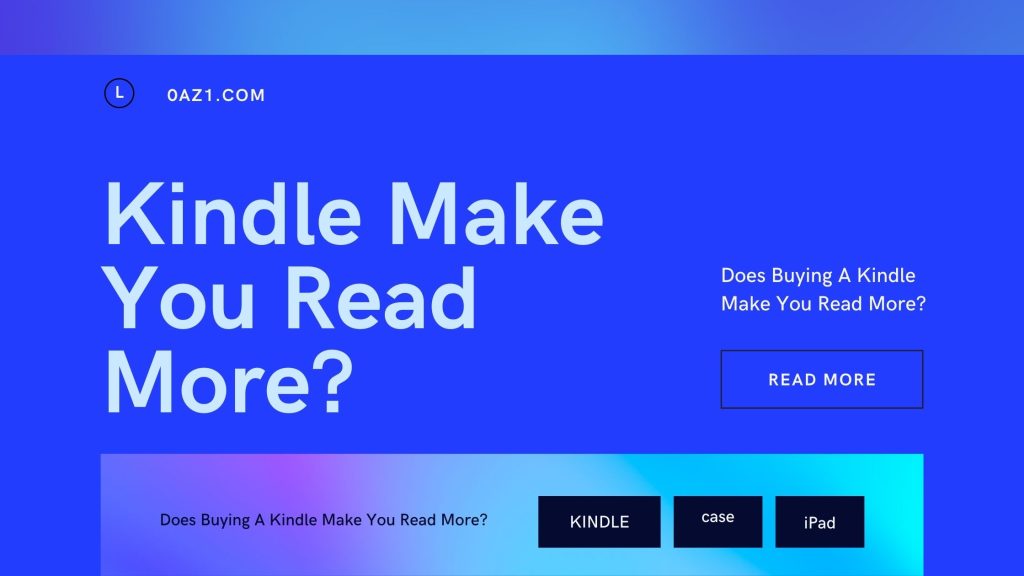In a world driven by technology, where digital devices have become ubiquitous, e-books and e-readers like Amazon Kindle have gained immense popularity. The question often arises: “Does buying a Kindle make you read more?” Let’s explore the influence of Kindle on reading habits and the factors that come into play, the Kindle offers several advantages for book lovers. Firstly, it provides unparalleled portability. You can carry an entire library of books in a lightweight device, making reading on the go effortless. The adjustable font size and style accommodate individual preferences, ensuring a comfortable reading experience for everyone. Moreover, the Kindle opens up a world of literature, giving you access to an extensive library at your fingertips.
How A Kindle Make You Read More

However, the rise of Kindle and e-books also comes with potential drawbacks. Digital distractions are a significant concern. With the allure of the internet and other apps on the same device, maintaining focus on reading can be challenging. Additionally, prolonged screen time can lead to eye strain, a drawback seldom associated with traditional printed books. The tactile experience of flipping physical pages and the smell of paper can be missed by Kindle readers.
Reader Experiences: Kindle vs. Physical Books
To understand the impact of Kindle on reading habits, it’s crucial to consider individual experiences. Many readers have shared their preferences, some swearing by the convenience and versatility of the Kindle, while others express a fondness for the tangible feel of physical books. Some find themselves reading more with a Kindle due to its ease of use and accessibility, while others appreciate the sensory experience that a physical book provides.
Factors Influencing Reading Habits
The decision of whether to opt for a Kindle or stick to physical books is influenced by various factors. Convenience plays a significant role—being able to carry your entire library in a compact device is an undeniable advantage. Moreover, personal preferences and habits shape reading choices. Some readers love the smell and feel of a book, while others embrace the technological advancements and features offered by e-readers.
Why Do People Read More On A Kindle?

Kindle, Amazon’s line of e-readers, has witnessed a surge in popularity over the years. This portable device has transformed the way people consume books and literature. In this article, we’ll explore the reasons why people are inclined to read more on a Kindle, covering aspects such as portability, eye comfort, access to a vast library, customization, cost-effectiveness, and its eco-friendly nature.
E-readers have become a staple for modern book enthusiasts. Among them, Kindle has gained remarkable traction due to its sleek design and convenient features. In this digital era, where technology continuously shapes our lives, e-readers have revolutionized reading habits. The focal point of this article is to unravel the factors that entice individuals to read more on a Kindle.
Portability and Convenience
One of the standout features of a Kindle is its portability. Unlike traditional books, a Kindle is lightweight, compact, and easily portable. Whether you’re commuting to work, waiting for an appointment, or traveling, the Kindle can conveniently slip into your bag or pocket. This ease of transport means that people are more likely to carry their reading material wherever they go, thereby encouraging increased reading on-the-go.
E-ink Technology and Eye Comfort
A significant factor contributing to the Kindle’s appeal is the E-ink technology. E-ink displays replicate the look of ink on paper, reducing strain on the eyes. Unlike the glare emitted by electronic screens, a Kindle’s display closely resembles the appearance of printed text, leading to a more comfortable reading experience. This eye-friendly feature ensures that readers can indulge in lengthy reading sessions without experiencing the typical discomfort associated with extended screen time.
Access to a Vast Library
The Kindle provides access to an extensive and diverse digital library. With millions of e-books available at your fingertips, readers can explore a wide array of genres, topics, and authors. This vast selection caters to different tastes and preferences, ensuring there’s something for everyone. The sheer variety of e-books available encourages readers to delve into different genres, fostering a reading habit that might not have been as easily nurtured with traditional books.
Customization and Accessibility Features
Kindle offers an abundance of customization options that appeal to readers. From adjusting font sizes to changing background colors, readers can tailor their reading experience to suit their preferences. This high level of customization accommodates individuals with varying reading needs, making the Kindle an inclusive platform for readers. The accessibility features ensure that more people can comfortably enjoy reading, further fueling their engagement with the device.
Cost-Effectiveness and Eco-Friendly Nature
When considering the cost of physical books, e-books often present a more economical choice. E-books are generally priced lower than their printed counterparts, making reading an affordable hobby. Furthermore, opting for e-books minimizes the need for paper, reducing the environmental impact associated with traditional publishing. In a world increasingly conscious of sustainability, the Kindle’s eco-friendly nature is a compelling reason for many to choose it as their preferred reading platform.
Is It Better For Your Eyes To Read From Kindle Or A Book?

In a world where digital innovations constantly alter our traditional practices, the way we read has also undergone a significant transformation. With the advent of e-readers like the Kindle, readers are now faced with a choice: read on a screen or stick to the conventional book? This article delves into the question that plagues many book enthusiasts – Is it better for your eyes to read from a Kindle or a traditional book?
Understanding the Mechanisms
To unravel the impact on our eyes, we need to understand how the eyes operate during the act of reading. Reading involves complex eye movements and focusing mechanisms. In the case of a traditional book, we engage with printed text on paper, while a Kindle utilizes digital ink displayed on an electronic screen. These different mechanisms can influence how our eyes interact and perceive the content.
Comparing Eye Strain
One of the primary concerns when it comes to reading is eye strain. Extended periods of reading, whether on a Kindle or a book, can lead to eye discomfort. However, studies suggest that the type of eye strain might vary. Screen time, as experienced with e-readers, can lead to digital eye strain due to the blue light emitted by screens. On the other hand, reading a physical book might induce eye strain due to the constant adjustment of focus and the size of the text.
Considering Lighting and Glare
Lighting plays a crucial role in eye comfort during reading. When reading a book, external lighting conditions can affect the reading experience. In contrast, a Kindle comes with a built-in light, allowing for consistent illumination. However, the glare from the screen might pose a challenge for some readers, impacting their overall comfort and potentially causing eye strain.
Ergonomics and Reading Posture
The way we hold a book and a Kindle differs significantly. With a book, we can adjust its position to our liking, finding the most comfortable reading posture. On the other hand, the Kindle has a fixed screen position, potentially requiring readers to adjust their posture to accommodate it. This distinction in ergonomics can influence how we perceive eye strain and comfort while reading.
User Experience and Personal Preference
Ultimately, the choice between a Kindle and a book is a matter of personal preference and reading habits. Some individuals find the gentle glow of a Kindle’s screen comforting, while others appreciate the tactile feel of a physical book. The reading experience is subjective and varies from person to person based on their preferences, habits, and how they perceive eye comfort.
Do Ereaders Help You Read More?

In the modern era, technology has significantly influenced our reading habits. E-readers, like Amazon’s Kindle and other devices, have become increasingly popular, changing the way we approach reading. This article explores the question: Do e-readers help you read more? We’ll delve into various aspects of e-readers, from portability and accessibility to customization and engagement, to understand their impact on our reading habits.
Portability and Accessibility
E-readers have revolutionized the reading experience by providing unparalleled portability and accessibility. Instead of carrying multiple books in a bag, e-readers allow us to have an entire library at our fingertips. Imagine being able to switch between genres or books seamlessly during a long journey. This convenience encourages spontaneous reading, making it easier to read more, whether on a commute or a leisurely day at home.
Variety and Choice
One of the significant advantages of e-readers is the vast variety of books available. From classic literature to modern bestsellers, e-readers offer a diverse range of options to suit every taste. With a few taps, you can access a library that might rival the biggest bookstores. This variety promotes exploration and experimentation with different genres, potentially encouraging readers to read more by discovering new favorites.
Customization and Comfort
E-readers come with a range of customization options that enhance the reading experience. Readers can adjust the font size, choose different fonts, and even change the background color to suit their comfort. For those with visual impairments or specific preferences, this level of customization is invaluable. By providing a comfortable reading environment, e-readers can lead to extended reading sessions, enabling readers to consume more content.
Engagement and Interactive Features
E-readers are not just about displaying text; they incorporate interactive features that engage readers in a unique way. Functions like highlighting, making notes, adding bookmarks, and using a built-in dictionary foster an interactive reading experience. Readers can actively engage with the text, making the reading process dynamic and enriching. These features can encourage readers to delve deeper into the content, potentially leading to more reading time.
Studies and Statistics
Several studies have been conducted to understand the impact of e-readers on reading habits. According to a study by PricewaterhouseCoopers (PwC), the convenience and portability of e-readers lead to an increase in reading frequency. The study also highlighted that individuals who embraced e-readers reported reading more books annually compared to those who primarily read printed books. This data supports the notion that e-readers indeed contribute to enhanced reading habits.
Conclusion

In conclusion, whether buying a Kindle makes you read more depends on the individual. The Kindle has revolutionized the way we read, offering convenience and an extensive range of literature. However, it’s essential to consider the potential drawbacks and personal reading preferences. The choice between a Kindle and physical books ultimately lies in what suits your reading style and habits best.
FAQs:
- Is reading on a Kindle the same as reading a physical book?
- While the content remains the same, the experience differs. A Kindle offers a digital interface, adjustable settings, and portability, while a physical book provides a tactile and sensory experience.
- Do people tend to read more with a Kindle compared to physical books?
- Some individuals find it easier to read more with a Kindle due to its portability and accessibility, but preferences vary among readers.
- Can prolonged Kindle use lead to eye strain?
- Yes, extended screen time can cause eye strain. It’s essential to take breaks and adjust settings like font size to reduce strain.
- Are Kindle books cheaper than physical books?
- Generally, e-books on Kindle are more affordable than physical copies due to lower production costs.
- Are all books available on Kindle?
- A vast majority of books are available on Kindle, but there might be exceptions, especially with older or extremely rare titles.






